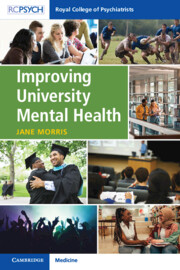Book contents
- Improving University Mental Health
- Improving University Mental Health
- Copyright page
- Contents
- Foreword
- Acknowledgements and Thanks to Contributors
- Chapter 1 Introducing This Handbook
- Chapter 2 Building a New Sense of Belonging
- Chapter 3 The Transition to University for New Students with Pre-Existing Mental Conditions
- Chapter 4 The Roles of Parents and Carers
- Chapter 5 Healthy Bodies, Body Image Concerns, Eating Disorders
- Chapter 6 Alcohol
- Chapter 7 Substance Misuse
- Chapter 8 Social (and Anti-social) Media
- Chapter 9 Finance and Mental Health
- Chapter 10 Neurodiversity
- Chapter 11 Ethnically Diverse University Communities
- Chapter 12 Sexual Behaviour and Gender Identity in Universities
- Chapter 13 The Mental Health of Teaching and Academic Staff
- Chapter 14 An Overview of Mental Disorders in Students and Staff
- Chapter 15 ‘Psychotic’ Disorders
- Chapter 16 Mood Disorders
- Chapter 17 Suicide at University
- Chapter 18 Mental Health Services on Campus and in the NHS
- Chapter 19 Students of the Professions and ‘Fitness to Practise’ Issues
- Chapter 20 Summing It All Up
- Index
- References
Chapter 17 - Suicide at University
Published online by Cambridge University Press: 08 February 2024
- Improving University Mental Health
- Improving University Mental Health
- Copyright page
- Contents
- Foreword
- Acknowledgements and Thanks to Contributors
- Chapter 1 Introducing This Handbook
- Chapter 2 Building a New Sense of Belonging
- Chapter 3 The Transition to University for New Students with Pre-Existing Mental Conditions
- Chapter 4 The Roles of Parents and Carers
- Chapter 5 Healthy Bodies, Body Image Concerns, Eating Disorders
- Chapter 6 Alcohol
- Chapter 7 Substance Misuse
- Chapter 8 Social (and Anti-social) Media
- Chapter 9 Finance and Mental Health
- Chapter 10 Neurodiversity
- Chapter 11 Ethnically Diverse University Communities
- Chapter 12 Sexual Behaviour and Gender Identity in Universities
- Chapter 13 The Mental Health of Teaching and Academic Staff
- Chapter 14 An Overview of Mental Disorders in Students and Staff
- Chapter 15 ‘Psychotic’ Disorders
- Chapter 16 Mood Disorders
- Chapter 17 Suicide at University
- Chapter 18 Mental Health Services on Campus and in the NHS
- Chapter 19 Students of the Professions and ‘Fitness to Practise’ Issues
- Chapter 20 Summing It All Up
- Index
- References
Summary
Suicide is a leading causes of student death, especially in young men, and appears to be increasing in prevalence. The most effective preventative measures so far involve limiting access to the means of self-destruction. Institutions can monitor the built environment for ‘suicide hotspots’ such as towers, bridges and car parks, and reduce access to chemicals and drugs on campus. Social media and other online activity appear to increase the likelihood of suicide. Alcohol and recreational drugs are strong risk factors. Individuals with autism are at high risk, as are those with a diagnosis of bipolar disorder. Students who have to take time out of academic studies – or to leave – are especially vulnerable. Warning signs include social withdrawal, academic failure and low mood. Asking about suicidal thoughts appears not to increase the likelihood of suicide, but may be protective. Support pathways for distressed students and staff should be regularly reviewed. Websites should be kept updated with helpful links, including simple instructions for crisis management. Information-sharing agreements should be reviewed to consider permissions to contact next of kin. All institutions need a suicide ‘postvention’ plan and team in readiness to compassionately manage the rare but devastating occurrence of suicide.
Keywords
- Type
- Chapter
- Information
- Improving University Mental Health , pp. 260 - 279Publisher: Cambridge University PressPrint publication year: 2024



